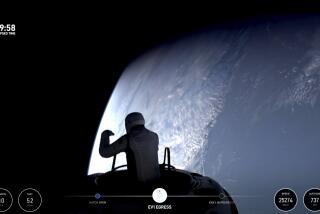Jeff Bezos shows off Blue Origin’s crew capsule that could soon take tourists to space
- Share via
The seats are comfortable, laid back with headrests like in a dentist’s office. The walls are padded and white, and there are handles all over the place so that the floating astronauts can hang on like people riding the subway.
But it’s the windows that are the defining feature of the spacecraft that Jeffrey Bezos showed off on Wednesday at the Space Symposium, a conference in Colorado Springs, Colo.
In a year or more — Bezos said the timing hasn’t yet been decided — his space company Blue Origin plans to begin flying tourists past the edge of space, 62 miles high, where for about four minutes they’ll experience the thrill of weightlessness and view the curvature of Earth.
“Everybody says that when you go to space, it changes you,” said Bezos, the founder of Amazon.com and the owner of the Washington Post. “All the astronauts come back with stories like that. It’s very emotional to see this Earth, to see the thin layer of the atmosphere.”
Blue Origin is one of several entrepreneurial companies that are seeking to lower the cost of access to space, and touch off what Bezos said could become a “golden age of space.”
In addition to Blue Origin, Elon Musk’s SpaceX has accomplished a series of feats, such as becoming the first commercial venture to fly a spacecraft to the International Space Station. Last week, SpaceX became the first company to re-fly the first stage of a rocket that had delivered a payload to orbit.
Virgin Galactic, founded by Richard Branson, also plans to fly tourists to space, and is in the middle of testing its new space plane, SpaceShipTwo, which would be tethered to the bellow of a mother ship and then launched in flight. Virgin charges $250,000 a flight; Blue Origin hasn’t yet decided what its tickets would cost.
Flanked by the Blue Origin spacecraft and the New Shepard booster, which has flown past the edge of space five times, Bezos said the company could begin flying paying customers by as soon as 2018, but that the schedule is fluid. While his “singular focus is people in space,” the flight-testing program will be deliberate and painstaking, he said.
“We are not racing,” he said. “This vehicle is going to carry humans. We’re going to make it as safe as we can make it. ... We’re not going to take any shortcuts.”
The goal of Blue Origin, the space company Bezos founded in 2000, is to one day help enable “millions of people living and working in space,” as Bezos likes to say. Space tourism is a first step on that journey, Bezos said, a way for the company to practice launching on a frequent basis.
The suborbital tourist flights would require minimal training, he said, and be quick, just 10 or 11 minutes. As many as six passengers would board the spacecraft about 30 minutes before liftoff. Near the flight’s apogee, the capsule would separate from a booster that would fly back and land on the ground. The capsule would continue climbing, allowing the passengers to unbuckle and float around the cabin for about four minutes before the return flight down.
Upon reentry, the passengers would for a few moments experience 5 Gs, or five times the gravitational force. At touchdown, the capsule would be traveling at about 2 mph.
And, no, people throwing up isn’t a serious concern, Bezos said.
“It takes about three hours before you start to throw up,” he said. “It’s a delayed effect, and this journey takes 10 or 11 minutes, so you’re going to be fine.”
To date, Blue Origin’s business model has been, “I sell about $1 billion a year of Amazon stock, and I use it to invest in Blue Origin.” But the company is also working on an orbital rocket, the New Glenn, which is expected to fly by 2020. The company has already signed up customers for that rocket, and is looking for more.
“I think it’s very important the Blue Origin stand on its own feet,” he said.
More to Read
Inside the business of entertainment
The Wide Shot brings you news, analysis and insights on everything from streaming wars to production — and what it all means for the future.
You may occasionally receive promotional content from the Los Angeles Times.










